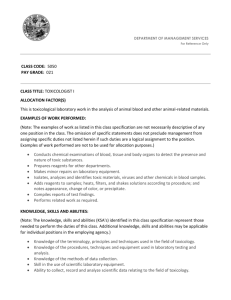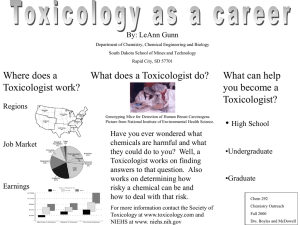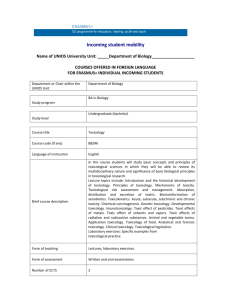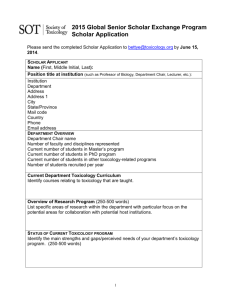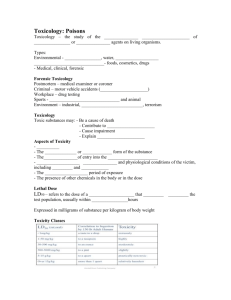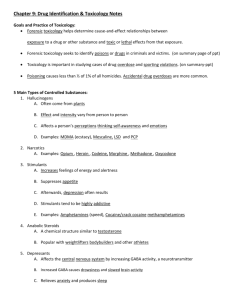MEDICAL TOXICOLOGY ROTATION FOR HOUSESTAFF
advertisement
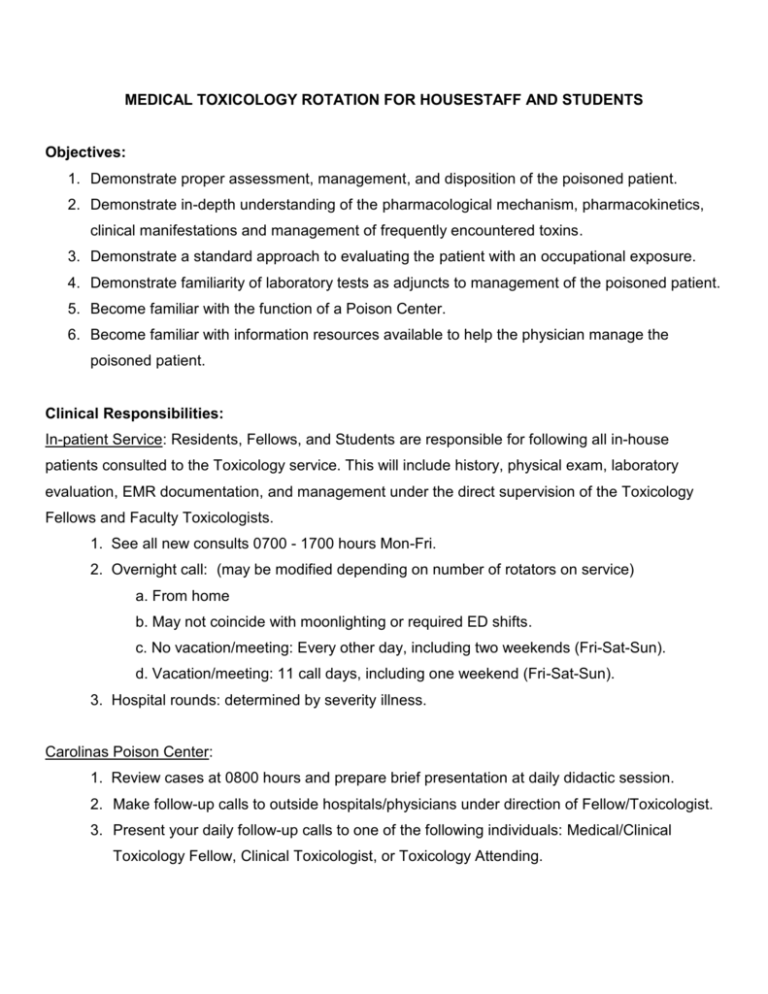
MEDICAL TOXICOLOGY ROTATION FOR HOUSESTAFF AND STUDENTS Objectives: 1. Demonstrate proper assessment, management, and disposition of the poisoned patient. 2. Demonstrate in-depth understanding of the pharmacological mechanism, pharmacokinetics, clinical manifestations and management of frequently encountered toxins. 3. Demonstrate a standard approach to evaluating the patient with an occupational exposure. 4. Demonstrate familiarity of laboratory tests as adjuncts to management of the poisoned patient. 5. Become familiar with the function of a Poison Center. 6. Become familiar with information resources available to help the physician manage the poisoned patient. Clinical Responsibilities: In-patient Service: Residents, Fellows, and Students are responsible for following all in-house patients consulted to the Toxicology service. This will include history, physical exam, laboratory evaluation, EMR documentation, and management under the direct supervision of the Toxicology Fellows and Faculty Toxicologists. 1. See all new consults 0700 - 1700 hours Mon-Fri. 2. Overnight call: (may be modified depending on number of rotators on service) a. From home b. May not coincide with moonlighting or required ED shifts. c. No vacation/meeting: Every other day, including two weekends (Fri-Sat-Sun). d. Vacation/meeting: 11 call days, including one weekend (Fri-Sat-Sun). 3. Hospital rounds: determined by severity illness. Carolinas Poison Center: 1. Review cases at 0800 hours and prepare brief presentation at daily didactic session. 2. Make follow-up calls to outside hospitals/physicians under direction of Fellow/Toxicologist. 3. Present your daily follow-up calls to one of the following individuals: Medical/Clinical Toxicology Fellow, Clinical Toxicologist, or Toxicology Attending. Toxicology Clinic: Evaluate environmental and occupational exposures, as well as follow-up cases under the supervision of the Fellow/Toxicologists. This clinic is held in the Fast Track Area of the ED on Tuesday mornings between 0830 and 1100 hours. Group Education: Monday-Tuesday-Friday Didactic Sessions: One to two hours daily to cover frequently encountered toxins, new consultations, cases followed by the Poison Center, and current toxicological literature. Didactic sessions may be in the form of a formal lecture/"chalk talk" by the Fellow/Toxicologist, a bedside presentation of a new consult by the resident/Fellow/Toxicologist, or a presentation and discussion of out-of-house cases currently followed by the Carolinas Poison Center. “Wicked Wednesday” Conference: held each Wednesday from 0900-1200 hr in the large conference room MEB 2nd floor and includes case presentations, review of deaths, journal club, outline presentations, pharmacology conference, and rotator mini-research projects. Rotators serve as primary reviewers for journal club articles Thursday EM Block Conference: Rotators are encouraged to attend block conference. Self-Directed Education: Rotator Presentations: The resident reading endeavors and search through resources will culminate in presentations to the Toxicology service and Poison Center staff. These presentations will include 1-2 outlines and one mini-research endeavor. Outlines: brief (no more than 5 minute) presentations that cover unusual or less common toxins or common medications/substances with uncommon adverse effects. (See attached “outline of the outlines.”) Topics may be generated by the rotator, from recent toxic news events, or the pending outline list posted at the CPC but should be topics not covered by didactic sessions. End of Month Presentation: The literature research endeavor can cover a particular aspect of toxicology that is of interest to the rotating resident/fellow/student, question generated by an unknown/controversial aspect of a consult, or journal club issue. To make this mini-research project plausible and of maximum value, it should focus on a narrow question. This will allow the rotator to gain experience in gathering and critically reviewing literature germane to toxicology. The presentation is in oral form (power point), should last approximately 30 minutes, and include a bibliography. A brief discussion period will follow the presentation. Start planning and working on this early in the month! Compendium Required Reading List: There are core toxicology subject articles located on the EM compendium that are required. They are composed of recent chapters from leading textbooks, landmark articles, and publications from CMC. Rotators will take a board-style exam at the end of the month based on these selected readings. A score of 72% is required to pass the exam. Resources: Residents will avail themselves to the following information resources: 1. Goldfrank's Toxicologic Emergencies (10th ED) 2. Ford’s Clinical Toxicology 3. Haddad, Shannon, and Winchester 4. AHEC Medline 5. Poison Center texts and journals (may not leave poison center) 6. Micromedex 7. Toxicology required reading list (available on the EM Compendium) Evaluation: Will be based on clinical performance, written/verbal presentations, participation at didactic sessions, passage of the test and whether or not you promise to apply for the Toxicology Fellowship (just kidding!). A formal test will be given at the end of the rotation based on the Toxicology Reading list. The rotator must pass the test (≥72%). Evaluations will be in writing. The resident/student and residency/student director will be notified in prompt fashion of any unsatisfactory performance so that this can be resolved prior to the completion of the rotation. The rotators are encouraged to provide constructive feedback regarding the rotation at any time. Directions to the Poison Center: Address: 4400 Golf Acres Drive, Charlotte, NC Take Wilkinson Blvd west towards the airport. Turn left onto Morris Field Dr (police station on right at intersection). Take first right onto Golf Acres. The Poison Center is in the first CHS corporate building on your right. FREQUENTLY ENCOUNTERED TOXINS- BREAD AND BUTTER TOXINS Acetaminophen Anticonvulsants Beta-Blockers Calcium Antagonists Carbon Monoxide Cocaine Cyanide Cyclic antidepressants Digitalis Envenomations Hydrocarbons Inhalation Injuries Lead Lithium Marine Toxins Mushrooms Organophosphates Poisonous Plants Salicylates Toxic Alcohols (diethylene glycol, ethylene glycol, isopropanol, methanol, propylene glycol) The “outline” for the outlines Joe Schmo 1/1/01 Introduction Structure and/or pictures (no need for pill size and color, but available doses is good). Pharmacology/Pharmacokinetics: o Absorption/Distribution/Metabolism/Excretion o Therapeutic levels (if appropriate with units). o Significant Drug/Drug interactions (Good clinical reports only) Metabolic Pathways and active metabolites Toxicity/Mechanism of Toxicity Clinical Toxicity/Presentation Laboratories Treatment/Management (if you list gastric lavage, syrup of Ipecac, or WBI, you had better have a good reference). References Clarify your topic with Drs Beuhler, Dulaney, Kerns, Kopec, Murphy, or Snow before starting as they may have guidance for what you want to focus on and we wish to limit repetition. Certain topics (such as arsenic) need to be broken into several smaller outlines to cover. Please put your name and the date presented on the top of the outline (you can do it like shown here if you wish to save space). Total size should be 2-4 pages, meaning it may fit on one 8”x11” piece of paper (double sided). Ideally they are photocopied so that 2 pages are on a single page (front/back). Don’t go too small-if you are using 8pt font to make it fit, you probably should extend it to 3 or 4 pages. Outline format is fine, but writing in prose is OK as well (but more work). Each section has different sizes depending on the agent. References: No need to list Goldfrank’s or Ford’s in the references as it is expected one looked there to start. You will need to request articles from the library for older/rarer toxins and in the situation where you need to look deeper into a referenced statement from one of the texts. Not everything in a text book is correct. If Micromedex is used, you MUST track down any statement you use from there but be warnedmany references in Micromedex are not correctly listed. Please take advantage of the following sources of references: Patty’s Industrial Hygiene (many volumes) Clinical Environmental Health and Toxic Exposures 2nd ed (Sullivan) Industrial Toxicology (Rom) Metabolic Drug Interactions (Levy) Wilderness Medicine (Auerbach) The pharmacological Basis of Theraputics (Goodman/Gillman) Disposition of Toxic Drugs and Chemicals in Man 5th ed (Baselt) http://www.fda.gov/medwatch/ The Files of Dr. Kerns, Rouse and Beuhler A good source for structures is (besides cutting and pasting) is http://chemfinder.cambridgesoft.com/ You only get 2 free searches before you have to register, so spell it right. Right click and save picture. Insert the picture into a Text box in your Outline.



